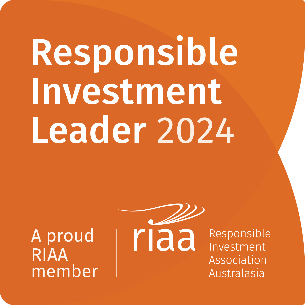Extreme measures for extreme circumstances - why the RBNZ has to cut the OCR by at least 0.75% when it meets this month

An interest piece written by Greg Smith, Head of Distribution at Devon Funds.
In last month’s special interest piece, we made the case for a 0.75% cut at each of the two final RBNZ meetings of the year. This was a non-consensus call. In the end, the central bank cut rates by 0.50% last month, but expectations following October’s CPI number have clearly shifted in terms of what will happen at the November meeting. The rate implied by markets is now ~4.18%. In other words, this suggests the odds are split between a 0.50% or a 0.75% cut this month. Within a relatively short space of time, the prospect of a 0.75% rate this month has gone from what was seen as an outlier call to one that is entirely “plausible.”
A general comment by dissenters to a cut of such magnitude is that such large reductions are generally reserved for “extreme” circumstances. It is not too difficult to argue that we are in such circumstances now.
But even before that, it is worth remembering that the Reserve Bank’s mandate was changed at the end of last year to a single operational objective of “…future annual inflation between 1 and 3 percent over the medium term, with a focus on keeping future inflation near the 2 percent mid-point”. Maximum sustainable employment is no longer an operational objective in the RBNZ’s remit. However, as a secondary objective they “Seek to avoid unnecessary instability in output, employment and interest rates, and the exchange rate”.
The September quarter CPI release showed that annual inflation is running at 2.2%, down from 3.3% in the June quarter. Expectations were for a print of around 2.2%-2.3%, and for a change, the miss to the bottom side was courtesy of lower non-tradeable (domestically driven) inflation, which is the lowest in three years, despite a surge in property rates.
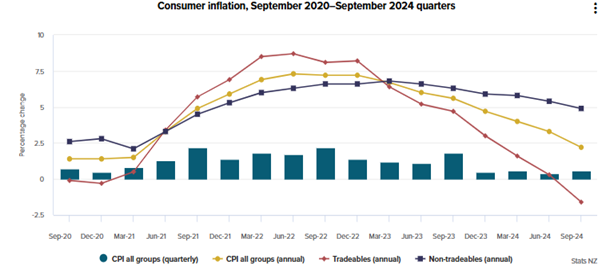
There was the mitigating factor of a 22.8% fall in early childhood education fees (a result of the government FamilyBoost rebate), but there’s no escaping the observation that inflation pressures are moderating. It is also worth highlighting that domestic inflation typically lags the labour market by ~6 months. Unemployment is rising, so inflation here might fall much faster yet. Meanwhile, annual tradable inflation is now at -1.6%, with falling fuel prices a factor.
On a quarterly basis, CPI inflation was just 0.6%, at the lower end of expectations, and just 0.2% on a seasonally adjusted basis (the lowest since the lockdown impacted the June quarter of 2020). On an annualised basis, seasonally adjusted inflation is just 1.2%. Core inflation measures like the 30% trimmed mean and the weighted median, on a quarterly basis, slowed to the lowest level since 2020.
For the first time since March 2021, annual headline inflation is within the RBNZ’s target band of 1% to 3%. Inflation could now go through the bottom of the band due to the recession. Having landed on a 0.50% reduction last month, should the RBNZ now look to play catch up and go with a 0.75% cut this month?
Inflation has fallen to within the bank’s target band at pace, and given the current downturn, it could undershoot the 2.0% midpoint and go right to the bottom of the band at 1%. It is therefore not hard to argue that we should be at, or below, the RBNZ’s “neutral” rate (neither boosting nor restricting growth) of 3.8% (some estimates of this are much lower) right now. The case for a 75-basis point reduction in the Official Cash Rate does indeed seem legitimate.
Interestingly a number of commentors who suggested only a few weeks ago that a 0.75% rate cut would be extreme, have now said that such a move is “plausible.”
The risk of undershooting inflation on the downside is particularly possible in economies such as ours which are facing numerous challenges and are effectively deflating. As noted in last month’s report, our economic data is dire, and the RBNZ should probably be pushing the panic button. The economy is in recession, and unemployment is on the rise. Various measures of confidence may be picking up, but from depressed levels, and are on the back of rate cuts which take time to filter through the economy.
We have had further evidence of the challenges that NZ is facing. The BNZ Business NZ Performance of Manufacturing report (titled “Long and slow road”) showed that while manufacturing activity ticked up in September, it remains in contractionary territory.
It is the same for the services sector. The PSI report showed that the services sector remained in contraction in September for the seventh consecutive month. The service PSI employment index also reversed back to its lowest result since February 2022. NZ is something of an anomaly, with the services sector in many other Western countries continuing to be in good shape. Key parts of the Kiwi economy do appear to be “stuck in a rut”, which therefore increases the need for “extraordinary measures.”
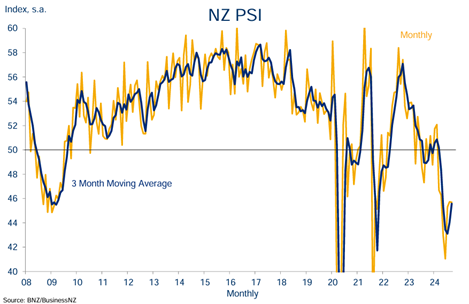
Meanwhile, there are some flashing red lights on other fronts. The growth outlook for China, our largest customer, remains uncertain. Officials in China have announced stimulus initiatives recently, but there remain question marks (as also noted by the RBNZ) about their effectiveness, which poses downside risks to New Zealand’s real export growth, as well as export and import prices.
Some other previous tailwinds are dissipating. The migration boom appears to be petering out with fewer inbound arrivals, while the brain drain of Kiwis appears now to be running at a record pace (56,100 annually on a net basis). The annual net migration gain in the year to August 2024 was 53,800, well down on the 67,200 in the July year, and less than half of the 127,700 seen in the year to August 2023. The long-term average for August years is a net migration gain of 28,200 so we are clearly above that, but the boom is dissipating.
Overall, migrant departures of 134,300 for the year are the highest on record. On a monthly basis, August saw a 38% decrease in migrant arrivals and a 43% increase in migrant departures from a year ago. We’ve got more Kiwis leaving in droves, and the number of non-NZ’ers coming is falling. These numbers reflect an economy that is in a tough spot, and unattractive compared to alternatives.

The slow-down in net migration (in addition to high interest rates of course) is also dampening housing demand. This was highlighted in the RBNZ’s semi-annual Financial Stability Report release this week. The central bank has highlighted how important housing is to the economy, accounting for most of the household wealth, while home loans make up 60% of bank lending. The RBNZ noted that housing market activity remains “subdued.”
Prices have fallen 14% since their late 2021 peak nationally, but with significant regional variations – prices in Auckland are down 20% while those in Wellington are down 23%. Inventories of homes available for sale have built up and days to sell remain elevated. There is a glut of townhouses, particularly in Auckland.
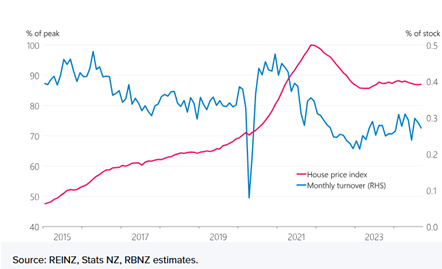
The bank sees house prices as still stretched for prospective buyers and around the top of their estimated sustainable levels. Tax policy changes (interest deductibility going to 100% from April 2025 and the recent reduction of the bright-line test to two years) may see investor activity pick up from weak levels. The bank said that financial stresses amongst developers were “normal” for this point in the development cycle.
The bank did note that while debt servicing stresses are elevated, several factors have mitigated the impact of the “boom-bust” cycle including a resilient labour market, high inflation (eroding real debt values), the fact that house prices were at their peak for only a brief period and strong business lending standards which have meant borrowers have built up financial buffers. The bank estimates that less than 2% of the current stock of lending is to borrowers in negative equity.
The RBNZ said that its recently activated limits on high debt-to-income mortgage lending will act as “guardrails.” That said, is it possible to contend that many parts of the economy are already “off the rails.”
The RBNZ noted that debt servicing costs are nearing their peak and beginning to decline, and the shift will make mortgage costs more “manageable” for households. However, the RBNZ admitted that domestic economic challenges remain. Many households and businesses are feeling financial pressure and rising unemployment is posing challenges for some borrowers. The RBNZ noted that banks anticipate a slight increase in non-performing loans, albeit still below levels seen in previous recessions.
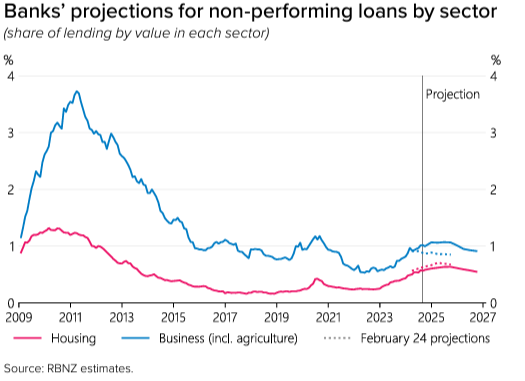
Does all this mean that officials should be forced into action stations now with a bigger rate cut?
Some good news is that a larger rate cut now will take less time to filter through to the economy than it did previously. Last month members of the Devon investment team attended a speech on the transmission of monetary policy given by Assistant Bank Governor Karen Silk, who noted that around 75% of new home loan flows currently carry interest periods of one year or less, and circa 70% of existing home loans will be repriced within the next nine months.
There is though something of an imperative with the central bank meeting on November 27, in that officials do not have their next meeting until February 19 2025. That’s nearly three months during which quite a lot can happen to our growth profile and not necessarily in a good way.
In addition to very large companies, we meet and talk with a lot of smaller businesses, and it is clear that many are struggling, and some are even on the brink of failure. A larger rate cut this side of Christmas might make all the difference.
There are those that contend a large rate cut is not warranted, considering the Fed in the US has stepped down from the jumbo 0.50% rate cut to a 0.25% reduction at its latest meeting this week. However, there are some additional points of relevance to note. The US economy is growing at 3% while New Zealand’s is contracting, and the Fed also holds meetings in December and January.
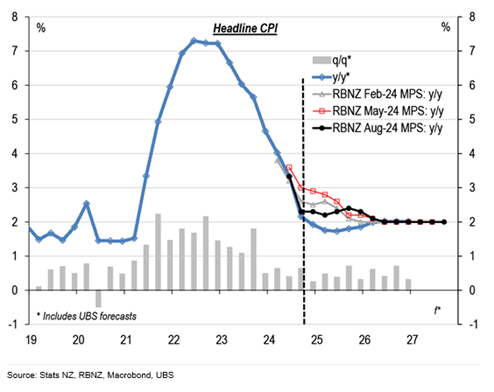
With this backdrop, will last month’s inflation figure be the straw that breaks the camel’s back and drives the RBNZ to cut rates by a thoroughly plausible 0.75%? Or might it depend on more incoming data in the coming weeks, including labour market data, and the September quarter unemployment rate (which reached 4.8%) and select monthly price indices out next week?
Or will the much-needed real jumbo cut be avoided altogether, to save an admission that the NZ economy is lagging many others and that rates were pushed up too high too fast and kept there for too long? Time will tell.
As a side note, the RBNZ this week said that the strength of NZ’s financial system means we can “weather economic uncertainties and challenges, including increased geopolitical tensions.” However, the outcome of the US election could be very relevant to New Zealand given Donald Trump’s plans to ramp up protectionism, particularly towards China.
